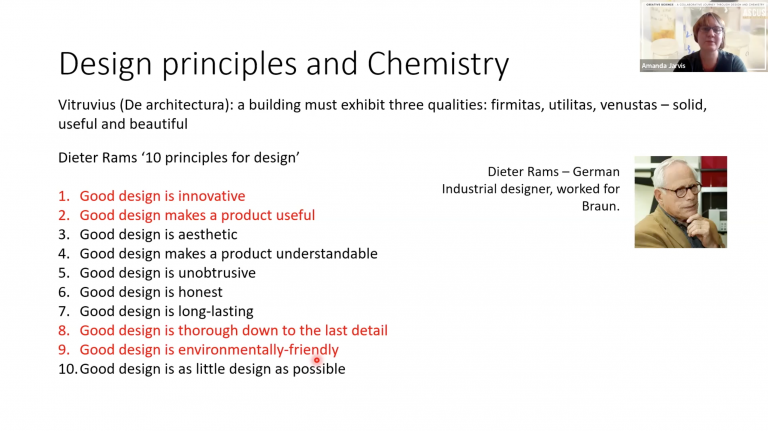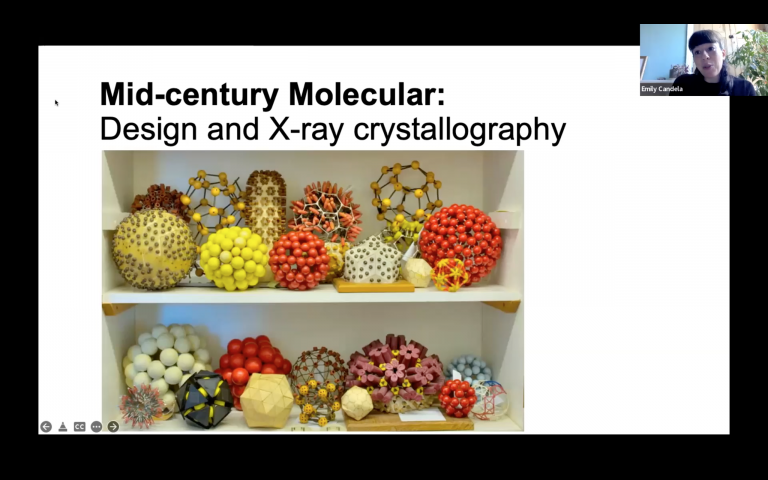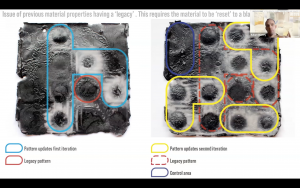Dispatches from the Lab #3: Adventures in Molecular Architectures
In August in the lab, we held the panel Molecular Architectures: Creative Science, a journey through design and chemistry. Keira (the lab manager) and I set up three different laptops and checked off all the potential technical difficulties we were trying to mitigate. That done, we put a sign on the door to keep fringe go-ers quiet while we worked. On the other end, our colleague Paula Nerlich started to welcome people and introduce ASCUS and the Molecular Architectures project.
People started joining our zoom call, saying hello from the Netherlands, Austria, England, Spain, Germany, Saudi Arabia and Cyprus. I love the capacity we collectively now have to meet in online spaces from around the world. Full transparency: as a medical anthropologist I am normally only interested in living things. My own prejudice (if you push me beyond politeness) is that chemistry is less interesting than biology and design is too functional to be fully free creatively. I didn’t know what to expect from a virtual room full of chemists and chemistry aficionados. However, I am pleased to report that I have had my prejudices challenged and my curiosity provoked.
Amanda Jarvis from the University of Edinburgh is the catalyst for the Molecular Architectures project. Amanda began with some fascinating questions about the relationship between creativity and science. Amanda revealed that she had been inspired by a workshop at ASCUS to explore the links between art, design and chemistry. She found that while chemistry may appear abstract or ‘hard’ shared areas of concern over sustainability, waste and functionality provide common ground for interdisciplinary conversations. Amanda shared with us her curiosity about how creativity connects design and science, the similarities between design and chemistry and how sharing knowledge, methods and processes can open up new possibilities for both disciplines.
Language, Collaboration and a Spark
Chaired by Emily Candela, the panel discussion invited scientists and designers to the virtual table. The creative duo John Hardy and Adam Blaney from Lancaster University shared of their collaborative endeavours into the potential of Chemistry in Multidisciplinary, Interdisciplinary, and Transdisciplinary Teaching. Rasa Weber, PhD candidate and design researcher from Matters of Activity, talked of her collaboration with UK based Chemist Richard Blackburn and the Leeds spin off Keracol within the design studio Blond and Bieber.
Throughout the event, one of the key themes throughout the event was collaboration itself. Everyone agreed that their experiences were positive and beneficial. The panellists agree that collaboration needs a relational connection in addition to an intellectual one; the panellists agreed that to find a good collaborator, you need to find a “spark” with someone and to really “feel it” before you begin working together. The panellists also agreed that interdisciplinary work should not be undertaken just because it is trendy. “Interdisciplinary work challenges you” John Hardy chimes in. One of the most important themes was language and that to make a good collaboration, you must “learn each other’s language”, but there is also a playful aspect to this. Discussing various ideas through analogies helped designer Adam and chemist John understand problems from new perspectives. They reflected that they found something fresh about talking with someone who is unfamiliar with your work and practice. “It challenges you, makes you stop and ask why you work in the way you work” Adam remarks. Adam and John laugh when they tell the audience “You can have weird conversations, conversations where 1+1 = 4”. Weird conversations create new possibilities.
From Cross-Disciplinary Collaborations to Interdisciplinarity
Rasa Weber is a designer who works with ecological architectures and is a specialist in weird collaborations. Rasa regales the audience with tales of humans creating the artificial growth of limestone underwater, part of an initiative to create architectures that are habitable for humans and other beings. Rasa’s work as a designer explores how we can grow materials rather than mining or extracting them from the environment, inspired by work on ‘fish architectures’.
The Inspiration and Conversation Continues
So are biomaterials better for a sustainable material resource? Rasa tells us “people tend to think, if it’s bio it is good and if it’s on the periodic table it is bad” or to put it another way, if something is “natural” it is good and if something is “chemical” it is bad. I love moments like these, when someone says something to me that challenges my assumptions and makes me reflect on how I see the world. Rasa tells us that there are no single solutions, chemical or biological. Chemicals have a bad reputation, but they can be used to create new coral reef-like structures for marine ecosystems. Biomaterials like algae are useful but to grow they still require a monoculture and that detracts from the ecosystem. Rasa explains there needs to be a shift for how designers collaborate with different forms of life and this is part of evolution. For Rasa, this means moving out of the lab and into the entangled messy environment. A self-confessed control freak, inviting chaos into collaborative design is a personal challenge as well as a theoretical one. Rasa draws on Lynn Margulis’s Symbiogenesis, the idea that evolution is not linear but instead “is a change in the single multidimensional being that has grown to cover the entire surface of the Earth”. So, how could symbiogenesis be activated for biodesign?
Answering that question is for another day. Team ASCUS thanks all panelists and the curious minds who joined to listen in :) and Keira and I shut off our laptops and head down into the colours and madness that is the first day of the Edinburgh Fringe Festival where similarly weird and wonderful conversations and collaborations will be happening all month. I will be back soon to bring you more dispatches from the lab, see you next time!
> Watch the panel now on our ASCUS Art & Science YouTube channel :D






